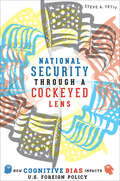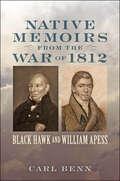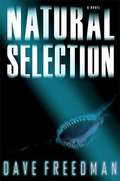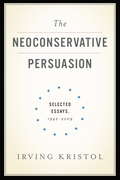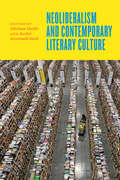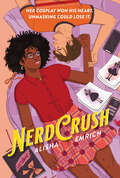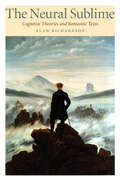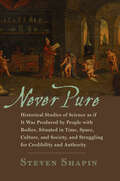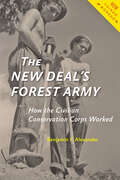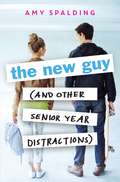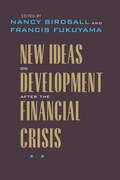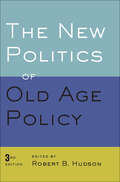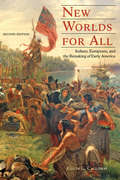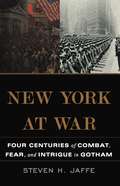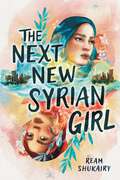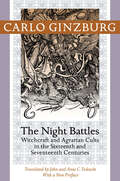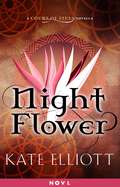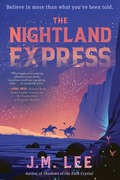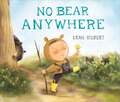- Table View
- List View
National Security through a Cockeyed Lens: How Cognitive Bias Impacts U.S. Foreign Policy
by Steve A. Yetiv"How do mental errors or cognitive biases undermine good decision making?" This is the question Steve A. Yetiv takes up in his latest foreign policy study, National Security through a Cockeyed Lens.Yetiv draws on four decades of psychological, historical, and political science research on cognitive biases to illuminate some of the key pitfalls in our leaders’ decision-making processes and some of the mental errors we make in perceiving ourselves and the world.Tracing five U.S. national security episodes—the 1979 Soviet invasion and occupation of Afghanistan; the Iran-Contra affair during the Reagan administration; the rise of al-Qaeda, leading to the 9/11 attacks; the 2003 U.S. invasion of Iraq; and the development of U.S. energy policy—Yetiv reveals how a dozen cognitive biases have been more influential in impacting U.S. national security than commonly believed or understood. Identifying a primary bias in each episode—disconnect of perception versus reality, tunnel vision ("focus feature"), distorted perception ("cockeyed lens"), overconfidence, and short-term thinking—Yetiv explains how each bias drove the decision-making process and what the outcomes were for the various actors. His concluding chapter examines a range of debiasing techniques, exploring how they can improve decision making.
Native Memoirs from the War of 1812: Black Hawk and William Apess (Johns Hopkins Books on the War of 1812)
by Carl BennNative peoples played major roles in the War of 1812 as allies of both the United States and Great Britain, but few wrote about their conflict experiences. Two famously wrote down their stories: Black Hawk, the British-allied chief of the still-independent Sauks from the upper Mississippi, and American soldier William Apess, a Christian convert from the Pequots who lived on a reservation in Connecticut. Carl Benn explores the wartime passages of their autobiographies, in which they detail their decisions to take up arms, their experiences in the fighting, their broader lives within the context of native-newcomer relations, and their views on such critical issues as aboriginal independence. Scholars, students, and general readers interested in indigenous and military history in the early American republic will appreciate these important memoirs, along with Benn's helpful introductions and annotations.
Natural Selection: A Novel
by Dave FreedmanA shocking biological discovery. A previously unknown predatory species. Evolving just like the dinosaurs. Now. Today. Being forced out of its world and into man's for a violent first encounter.Weaving science and thriller in a way not seen since Jurassic Park, Natural Selection introduces a phenomenally dangerous new species that is rapidly adapting in a way never before seen.A mystery. A chase. A vast expansive puzzle. A team of marine scientists is on the verge of making the most stunning discovery in the history of man. In their quest for answers, they engage a host of fascinating characters. The world's premier neurology expert. A specialist on animal teeth. Flight simulation wizards, evolution historians, deep sea geologists, and so many more.Along the way, the team of six men and women experience love, friendship, loyalty and betrayal. Together, they set off to exotic locales. Literally to the bottom of the ocean. To a vast and mysterious redwood forest. To an unknown complex of massive caves. When people start dying, the stakes are upped even further. Then the real hunt begins. . . .Loaded with astonishing action sequences, Natural Selection is that rare breed of thriller, filled with intricately layered research, real three-dimensional characters, and tornado pacing.
Natural Selection: A Novel
by Dave FreedmanA shocking biological discovery. A previously unknown predatory species. Evolving just like the dinosaurs. Now. Today. Being forced out of its world and into man's for a violent first encounter. Weaving science and thriller in a way not seen since Jurassic Park, Natural Selection introduces a phenomenally dangerous new species that is rapidly adapting in a way never before seen. A mystery. A chase. A vast expansive puzzle. A team of marine scientists is on the verge of making the most stunning discovery in the history of man. In their quest for answers, they engage a host of fascinating characters. The world's premier neurology expert. A specialist on animal teeth. Flight simulation wizards, evolution historians, deep sea geologists, and so many more. Along the way, the team of six men and women experience love, friendship, loyalty and betrayal. Together, they set off to exotic locales. Literally to the bottom of the ocean. To a vast and mysterious redwood forest. To an unknown complex of massive caves. When people start dying, the stakes are upped even further. Then the real hunt begins. . . . Loaded with astonishing action sequences, Natural Selection is that rare breed of thriller, filled with intricately layered research, real three-dimensional characters, and tornado pacing.
The Neoconservative Persuasion: Selected Essays, 1942-2009
by Irving KristolIrving Kristol, the "godfather" of neoconservatism and one of our most important public intellectuals, played an extraordinarily influential role in the development of American intellectual and political culture over the past half century. These essays, many hard to find and reprinted here for the first time since their initial appearance, are a penetrating survey of the intellectual development of one of the progenitors of neoconservatism.Kristol wrote over the years on a remarkably broad range of topics--from W. H. Auden to Ronald Reagan, from the neoconservative movement's roots in the 1940s at City College to American foreign policy, from religion to capitalism. Kristol's writings provide us with a unique guide to the development of neoconservatism as one of the leading strains of thought--one of the leading "persuasions"--in recent American political and intellectual history.
Neoliberalism and Contemporary Literary Culture
by Mitchum Huehls Rachel Greenwald SmithNeoliberalism has been a buzzword in literary studies for well over a decade, but its meaning remains ambiguous and its salience contentious. In Neoliberalism and Contemporary Literary Culture, Mitchum Huehls and Rachel Greenwald Smith offer a wide-ranging exploration of contemporary literature through the lens of neoliberalism;€™s economic, social, and cultural ascendance. Bringing together accessible and provocative essays from top literary scholars, this innovative collection examines neoliberalism;€™s influence on literary theory and methodology, literary form, literary representation, and literary institutions. A four-phase approach to the historical emergence of neoliberalism from the early 1970s to the present helps to clarify the complexity of the relationship between neoliberalism and literary culture. Layering that history over the diverse changes in a US-Anglo literary field that has moved away from postmodern forms and sensibilities, the book argues that many literary developments;¢;‚¬;€?including the return to realism, the rise of the memoir, the embrace of New Materialist theory, and the pursuit of aesthetic autonomy;¢;‚¬;€?make more coherent sense when viewed in light of neoliberalism;€™s ever-increasing expansion into the cultural sphere.The essays gathered here engage a diverse range of theorists, including Michel Foucault, Wendy Brown, Giorgio Agamben, Bruno Latour, Maurice Merleau-Ponty, Gary Becker, and Eve Sedgwick to address the reciprocal relationship between neoliberalism and conceptual fields such as biopolitics, affect, phenomenology, ecology, and new materialist ontology. These theoretical perspectives are complemented by innovative readings of contemporary works of literature by writers such as Jennifer Egan, Ben Lerner, Gillian Flynn, Teju Cole, Jonathan Franzen, Chimamanda Ngozi Adichie, Salvador Plascencia, E. L. James, Lisa Robertson, Kenneth Goldsmith, and many others. Neoliberalism and Contemporary Literary Culture is essential reading for anyone invested in the ever-changing state of literary culture.
Neoliberalism and Contemporary Literary Culture
by Mitchum Huehls Rachel Greenwald SmithNeoliberalism has been a buzzword in literary studies for well over a decade, but its meaning remains ambiguous and its salience contentious. In Neoliberalism and Contemporary Literary Culture, Mitchum Huehls and Rachel Greenwald Smith offer a wide-ranging exploration of contemporary literature through the lens of neoliberalism;€™s economic, social, and cultural ascendance. Bringing together accessible and provocative essays from top literary scholars, this innovative collection examines neoliberalism;€™s influence on literary theory and methodology, literary form, literary representation, and literary institutions. A four-phase approach to the historical emergence of neoliberalism from the early 1970s to the present helps to clarify the complexity of the relationship between neoliberalism and literary culture. Layering that history over the diverse changes in a US-Anglo literary field that has moved away from postmodern forms and sensibilities, the book argues that many literary developments;¢;‚¬;€?including the return to realism, the rise of the memoir, the embrace of New Materialist theory, and the pursuit of aesthetic autonomy;¢;‚¬;€?make more coherent sense when viewed in light of neoliberalism;€™s ever-increasing expansion into the cultural sphere.The essays gathered here engage a diverse range of theorists, including Michel Foucault, Wendy Brown, Giorgio Agamben, Bruno Latour, Maurice Merleau-Ponty, Gary Becker, and Eve Sedgwick to address the reciprocal relationship between neoliberalism and conceptual fields such as biopolitics, affect, phenomenology, ecology, and new materialist ontology. These theoretical perspectives are complemented by innovative readings of contemporary works of literature by writers such as Jennifer Egan, Ben Lerner, Gillian Flynn, Teju Cole, Jonathan Franzen, Chimamanda Ngozi Adichie, Salvador Plascencia, E. L. James, Lisa Robertson, Kenneth Goldsmith, and many others. Neoliberalism and Contemporary Literary Culture is essential reading for anyone invested in the ever-changing state of literary culture.
NerdCrush
by Alisha EmrichHappily Ever Afters meets You've Got Mail in this geeky, Black Girl Magic filled debut romance about cosplay and finding the courage to be yourself. Ramona Lambert is a typical shy, artistic sixteen-year-old. She has a best friend whom she&’s known since they were in diapers; parents who love her; a love for cosplay; and a crush on the cute boy in her class. The only problem? Her best friend moved away; her parents don't quite understand her love of cosplay; and she is pretty sure her crush has no idea she exists. To escape her troubles, Ramona turns to cosplay and her original character, Rel, who gives her the confidence and freedom that she lacks in real life. Embracing this confidence, she decides to strike up an email conversation with her crush, Caleb Wolfe, from her cosplay account in the hopes getting to know him . . . and maybe win his heart. Then as Caleb and Ramona are swept up in their emails back and forth to each other, and Ramona falls even harder as he opens up about his hopes, insecurities, and his own geeky loves. However, as Caleb starts to grow closer and closer to Rel, he also strikes up a friendship with Ramona, who knows she can't keep the truth about Rel from Caleb but isn't sure she is ready to risk losing him. With an important cosplay convention coming up and the anxiety of her double-life weighing on her, Ramona has to decide if she&’ll hide behind her cosplay character forever or take the chance and let Caleb see the real her--because he might actually like her for who she is.
The Neural Sublime: Cognitive Theories and Romantic Texts
by Alan RichardsonThe Neural Sublime brings recent work in cognitive neuroscience to bear on some famously vexed issues in British Romantic studies. In exciting and unprecedented ways, Alan Richardson demonstrates how developments in the neurosciences can transform the study of literary history. Richardson presents six exemplary studies, each exploring a different intersection of Romanticism and the sciences of the mind and brain: the experience of the sublime and the neuroscience of illusion; the Romantic imagination and visual imaging; the figure of apostrophe and linguistic theory; fictional representations of the mind and "theory of mind" theory; depictions of sibling incest and neo-Darwinian theories of mental behavior; and representations of female speech and cognitive developmental psychology. Richardson’s insightful analysis opens fresh perspectives on British Romanticism, pointing scholars to new developments in cognitive literary studies. He combines elements of new historicist analysis with original—and much-needed—models for understanding language, subjectivity, and social behavior. Far from signaling a departure from the prevalent critical approaches of new historicism, Richardson argues, cognitive theory presents an essential complement to them.The Neural Sublime features an array of cognitive and neuroscientific approaches, providing an engaging and readable introduction to the emergent field of cognitive literary studies.
Never Pure: Historical Studies of Science as if It Was Produced by People with Bodies, Situated in Time, Space, Culture, and Society, and Struggling for Credibility and Authority
by Steven ShapinSteven Shapin argues that science, for all its immense authority and power, is and always has been a human endeavor, subject to human capacities and limits. Put simply, science has never been pure. To be human is to err, and we understand science better when we recognize it as the laborious achievement of fallible, imperfect, and historically situated human beings.Shapin’s essays collected here include reflections on the historical relationships between science and common sense, between science and modernity, and between science and the moral order. They explore the relevance of physical and social settings in the making of scientific knowledge, the methods appropriate to understanding science historically, dietetics as a compelling site for historical inquiry, the identity of those who have made scientific knowledge, and the means by which science has acquired credibility and authority.This wide-ranging and intensely interdisciplinary collection by one of the most distinguished historians and sociologists of science represents some of the leading edges of change in the scholarly understanding of science over the past several decades.
The New Deal's Forest Army: How the Civilian Conservation Corps Worked (How Things Worked)
by Benjamin F. AlexanderPropelled by the unprecedented poverty of the Great Depression, President Franklin D. Roosevelt established an array of massive public works programs designed to provide direct relief to America;€™s poor and unemployed. The New Deal;€™s most tangible legacy may be the Civilian Conservation Corps;€™s network of parks, national forests, scenic roadways, and picnic shelters that still mark the country;€™s landscape. CCC enrollees, most of them unmarried young men, lived in camps run by the Army and worked hard for wages (most of which they had to send home to their families) to preserve America;€™s natural treasures. In The New Deal;€™s Forest Army, Benjamin F. Alexander chronicles how the corps came about, the process applicants went through to get in, and what jobs they actually did. He also explains how the camps and the work sites were run, how enrollees spent their leisure time, and how World War II brought the CCC to its end. Connecting the story of the CCC with the Roosevelt administration;€™s larger initiatives, Alexander describes how FDR;€™s policies constituted a mixed blessing for African Americans who, even while singled out for harsh treatment, benefited enough from the New Deal to become an increasingly strong part of the electorate behind the Democratic Party. The CCC was the only large-scale employment program whose existence FDR foreshadowed in speeches during the 1932 campaign;¢;‚¬;€?and the dearest to his heart throughout the decade that it lasted. Alexander reveals how the work itself left a lasting imprint on the country;€™s terrain as the enrollees planted trees, fought forest fires, landscaped public parks, restored historic battlegrounds, and constructed dams and terraces to prevent floods. A uniquely detailed exploration of life in the CCC, The New Deal;€™s Forest Army compellingly demonstrates how one New Deal program changed America and gave birth to both contemporary forestry and the modern environmental movement.
The New Deal's Forest Army: How the Civilian Conservation Corps Worked (How Things Worked)
by Benjamin F. AlexanderPropelled by the unprecedented poverty of the Great Depression, President Franklin D. Roosevelt established an array of massive public works programs designed to provide direct relief to America;€™s poor and unemployed. The New Deal;€™s most tangible legacy may be the Civilian Conservation Corps;€™s network of parks, national forests, scenic roadways, and picnic shelters that still mark the country;€™s landscape. CCC enrollees, most of them unmarried young men, lived in camps run by the Army and worked hard for wages (most of which they had to send home to their families) to preserve America;€™s natural treasures. In The New Deal;€™s Forest Army, Benjamin F. Alexander chronicles how the corps came about, the process applicants went through to get in, and what jobs they actually did. He also explains how the camps and the work sites were run, how enrollees spent their leisure time, and how World War II brought the CCC to its end. Connecting the story of the CCC with the Roosevelt administration;€™s larger initiatives, Alexander describes how FDR;€™s policies constituted a mixed blessing for African Americans who, even while singled out for harsh treatment, benefited enough from the New Deal to become an increasingly strong part of the electorate behind the Democratic Party. The CCC was the only large-scale employment program whose existence FDR foreshadowed in speeches during the 1932 campaign;¢;‚¬;€?and the dearest to his heart throughout the decade that it lasted. Alexander reveals how the work itself left a lasting imprint on the country;€™s terrain as the enrollees planted trees, fought forest fires, landscaped public parks, restored historic battlegrounds, and constructed dams and terraces to prevent floods. A uniquely detailed exploration of life in the CCC, The New Deal;€™s Forest Army compellingly demonstrates how one New Deal program changed America and gave birth to both contemporary forestry and the modern environmental movement.
The New Guy (and Other Senior Year Distractions)
by Amy SpaldingFilled with romance, rivalry, and passive-aggressive dog walking, Amy Spalding delivers a hilariously relatable story about how even the best-laid plans sometimes need to be rewritten.What's the only thing that could derail overachiever Jules's perfect senior year? Alex Powell--former member of boy-band sensation Chaos 4 All and newest transfer to Eagle Vista Academy. Alex seems cool enough when he starts spending time with Jules. In fact, he turns out to be quite the romantic (not to mention a killer kisser). And after getting over the initial shock that someone like Alex might actually like like her, Jules accepts that having a boyfriend could be a nice addition to her packed schedule. That is, until Alex commits the ultimate betrayal, which threatens to ruin her high school career, and possibly her entire future. This. Means. War.
New Ideas on Development after the Financial Crisis (Forum on Constructive Capitalism)
by Francis Fukuyama Nancy BirdsallThe global financial crisis of 2008–9 has changed the way people around the world think about development. The market-friendly, lightly regulated model of capitalism promoted by the United States is now at risk, and development thinking worldwide is at something of an impasse. Editors Nancy Birdsall and Francis Fukuyama bring together leading scholars to explore the implications of the global financial crisis on existing and future development strategies.In addressing this issue, the contributors contemplate three central questions: What effect has the crisis had on current ideas in development thinking? How has it affected and how will it affect economic policy and political realities in Latin America and Asia, including China and India? Will the financial collapse reinforce shifts in geopolitical power and influence, and in what form? Essays answering these questions identify themes that are essential as economic and political leaders address future challenges of development.To help move beyond this time of global economic turmoil, the contributors—the foremost minds in the field of international development—offer innovative ideas about stabilizing the international economy and promoting global development strategies. Contributors: Nancy Birdsall, Center for Global Development; Michael Clemens, Center for Global Development; Kemal Derviş, Brookings Institution; Larry Diamond, Stanford University; Francis Fukuyama, Stanford University; Peter S. Heller, Johns Hopkins University; Yasheng Huang, Massachusetts Institute of Technology; Justin Yifu Lin, World Bank; José Antonio Ocampo, Columbia University; Mitchell A. Orenstein, Johns Hopkins University; Minxin Pei, Claremont McKenna College; Lant Pritchett, Harvard University; Liliana Rojas-Suarez, Center for Global Development; Arvid Subramanian, Johns Hopkins University
The New Politics of Old Age Policy
by Robert B. HudsonAs the average age of the U.S. population continues to increase, age-related policies have come under intense scrutiny, sparking heated debates. In the past, older people were seen as a frail, dependent population, but major policies enacted or expanded on their behalf have made them major players in electoral and interest-group politics. This thoroughly revised and updated edition of Robert B. Hudson’s The New Politics of Old Age Policy not only explains the politics behind the country’s age-based programs and describes how those programs work but also assesses how wellâ€�or poorlyâ€�they meet the growing and changing needs of older Americans. Essays by leading experts in political science, sociology, law, social work, and gerontology address, among other things, theoretical approaches to age-based policy; population dynamics and the impact of growing diversity within the older population; and national, state, and local issues associated with major age-based programs. More than any other source, this book presents the most current information on growing older in the United States, including in-depth analyses of Social Security, Medicare, Medicaid, housing initiatives, the Older Americans Act, the Age Discrimination in Employment Act, and tax policy.Detailed new chapters focus on financial security and retirement in the context of the Great Recession, diversity and inequality in aging populations, and implications of the Affordable Care Act. Scholars, students, and policymakers will appreciate the volume’s timely overview of the evolution of aging policy.
The New Politics of Old Age Policy
by Robert B. HudsonAs the average age of the U.S. population continues to increase, age-related policies have come under intense scrutiny, sparking heated debates. In the past, older people were seen as a frail, dependent population, but major policies enacted or expanded on their behalf have made them major players in electoral and interest-group politics. This thoroughly revised and updated edition of Robert B. Hudson’s The New Politics of Old Age Policy not only explains the politics behind the country’s age-based programs and describes how those programs work but also assesses how well—or poorly—they meet the growing and changing needs of older Americans. Essays by leading experts in political science, sociology, law, social work, and gerontology address, among other things, theoretical approaches to age-based policy; population dynamics and the impact of growing diversity within the older population; and national, state, and local issues associated with major age-based programs. More than any other source, this book presents the most current information on growing older in the United States, including in-depth analyses of Social Security, Medicare, Medicaid, housing initiatives, the Older Americans Act, the Age Discrimination in Employment Act, and tax policy.Detailed new chapters focus on financial security and retirement in the context of the Great Recession, diversity and inequality in aging populations, and implications of the Affordable Care Act. Scholars, students, and policymakers will appreciate the volume’s timely overview of the evolution of aging policy.
New Worlds for All: Indians, Europeans, and the Remaking of Early America (The American Moment)
by Colin G. CallowayAlthough many Americans consider the establishment of the colonies as the birth of this country, in fact early America existed long before the arrival of the Europeans. From coast to coast, Native Americans had created enduring cultures, and the subsequent European invasion remade much of the land and society. In New Worlds for All, Colin G. Calloway explores the unique and vibrant new cultures that Indians and Europeans forged together in early America. The journey toward this hybrid society kept Europeans' and Indians' lives tightly entwined: living, working, worshiping, traveling, and trading together—as well as fearing, avoiding, despising, and killing one another. In some areas, settlers lived in Indian towns, eating Indian food. In the Mohawk Valley of New York, Europeans tattooed their faces; Indians drank tea. A unique American identity emerged.The second edition of New Worlds for All incorporates fifteen years of additional scholarship on Indian-European relations, such as the role of gender, Indian slavery, relationships with African Americans, and new understandings of frontier society.
New Worlds for All: Indians, Europeans, and the Remaking of Early America (The American Moment)
by Colin G. CallowayAlthough many Americans consider the establishment of the colonies as the birth of this country, in fact early America existed long before the arrival of the Europeans. From coast to coast, Native Americans had created enduring cultures, and the subsequent European invasion remade much of the land and society. In New Worlds for All, Colin G. Calloway explores the unique and vibrant new cultures that Indians and Europeans forged together in early America. The journey toward this hybrid society kept Europeans' and Indians' lives tightly entwined: living, working, worshiping, traveling, and trading together—as well as fearing, avoiding, despising, and killing one another. In some areas, settlers lived in Indian towns, eating Indian food. In the Mohawk Valley of New York, Europeans tattooed their faces; Indians drank tea. A unique American identity emerged.The second edition of New Worlds for All incorporates fifteen years of additional scholarship on Indian-European relations, such as the role of gender, Indian slavery, relationships with African Americans, and new understandings of frontier society.
New York at War: Four Centuries of Combat, Fear, and Intrigue in Gotham
by Steven H. Jaffethe need to try.Stretching from the colonial era to 9/11 and beyond, New York at War is that most rare of books: a work of history that is at once local and international, timely and timeless. Bringing a unique lens to bear on the world's most celebrated and contested city, Jaffe reveals the unimaginable ways the city has changed-and how it has stubbornly endured-under threats both external and internal.
The Next New Syrian Girl
by Ream ShukairyFuria meets I Am Not Your Perfect Mexican Daughter about the unlikely friendship between two very different Syrian girls, the pressures and expectations of the perfect Syrian daughter, and the repercussions of the Syrian Revolution both at home and abroad. Khadija Shami is a Syrian American high school senior raised on boxing and football. Saddled with a monstrous ego and a fierce mother to test it, she dreams of escaping her sheltered life to travel the world with her best friend. Leene Tahir is a Syrian refugee, doing her best to adjust to the wildly unfamiliar society of a suburban American high school while battling panic attacks and family pressures. When their worlds collide the result is catastrophic. To Khadija, Leene embodies the tame, dutiful Syrian ideal she's long rebelled against. And to Leene, Khadija is the strong-willed, closed-off American who makes her doubt her place in the world. But as Khadija digs up Leene&’s past, a startling and life-changing discovery forces the two of them closer together. As the girls secretly race to unravel the truth, a friendship slowly and hesitantly begins blooming. Doubts are cast aside as they realize they have more in common than they each expected. What they find takes them on a journey all the way to Jordan, challenging what each knows about the other and herself. Fans of Samira Ahmed&’s Love, Hate, and Other Filters and Tahereh Mafi&’s A Very Large Expanse Of Sea will love Khadija and Leene&’s sharp-witted voices in this dual POV narrative. The Next New Syrian Girl is a poignant and timely blend of guilt, nostalgia, devotion, and bad-ass hijabees.
The Night Battles: Witchcraft and Agrarian Cults in the Sixteenth and Seventeenth Centuries
by Carlo GinzburgBased on research in the Inquisitorial archives of Northern Italy, The Night Battles recounts the story of a peasant fertility cult centered on the benandanti, literally, "good walkers." These men and women described fighting extraordinary ritual battles against witches and wizards in order to protect their harvests. While their bodies slept, the souls of the benandanti were able to fly into the night sky to engage in epic spiritual combat for the good of the village. Carlo Ginzburg looks at how the Inquisition's officers interpreted these tales to support their world view that the peasants were in fact practicing sorcery. The result of this cultural clash, which lasted for more than a century, was the slow metamorphosis of the benandanti into the Inquisition's mortal enemies—witches.Relying upon this exceptionally well-documented case study, Ginzburg argues that a similar transformation of attitudes—perceiving folk beliefs as diabolical witchcraft—took place all over Europe and spread to the New World. In his new preface, Ginzburg reflects on the interplay of chance and discovery, as well as on the relationship between anomalous cases and historical generalizations.
The Night Battles: Witchcraft and Agrarian Cults in the Sixteenth and Seventeenth Centuries (Routledge Library Editions: Witchcraft Ser.)
by Carlo GinzburgBased on research in the Inquisitorial archives of Northern Italy, The Night Battles recounts the story of a peasant fertility cult centered on the benandanti, literally, "good walkers." These men and women described fighting extraordinary ritual battles against witches and wizards in order to protect their harvests. While their bodies slept, the souls of the benandanti were able to fly into the night sky to engage in epic spiritual combat for the good of the village. Carlo Ginzburg looks at how the Inquisition's officers interpreted these tales to support their world view that the peasants were in fact practicing sorcery. The result of this cultural clash, which lasted for more than a century, was the slow metamorphosis of the benandanti into the Inquisition's mortal enemies—witches.Relying upon this exceptionally well-documented case study, Ginzburg argues that a similar transformation of attitudes—perceiving folk beliefs as diabolical witchcraft—took place all over Europe and spread to the New World. In his new preface, Ginzburg reflects on the interplay of chance and discovery, as well as on the relationship between anomalous cases and historical generalizations.
Night Flower: A Court of Fives Novella (Court of Fives)
by Kate ElliottThis gorgeous romance from World Fantasy Award finalist Kate Elliott is a prequel to Court of Fives, the epic story of Jessamy and her struggle to do what she loves in a society suffocated by rules of class and privilege.Kiya is a Commoner who has just arrived in the bustling city of Saryenia. Esladas is a member of the Patron ruling class and determined to prove himself in the army. His plans are disrupted by the outgoing and beautiful girl who sells him fruit in the market, though, despite the fact that neither of them speaks a word of the others language. Brief conversations and stolen moments together soon become something more, but when their divided cultures clash, Kiya and Esladas must decide if their blossoming love is worth becoming outsiders for the rest of their lives. Read the beginning of their legendary love story in this Court of Fives companion novella!
The Nightland Express
by J. M. LeeIn antebellum America, two teens bury their secrets and join the historic Pony Express, and soon discover the mortal world is not the only one on the brink of war.
No Bear Anywhere
by Leah GilbertA young boy learns to cope with disappointment and embrace the unexpected in this infectiously charming, beautifully illustrated picture book.When his family takes a walk on Bear Creek Trail, Bruin is determined to spot his favorite animal (a bear). Before too long, he notices something! It's a . . . pinecone! Not a bear, but that's okay. A few minutes later, Bruin stops again: He's seen a . . . flower! No bear anywhere, but there's still plenty of time. Eventually, they make it all the way to the . . . cave! But when there is no bear anywhere in the cave, Bruin is as sad as could be. Can he turn his day around, even when there's no bear? Or, wait a minute-was a bear there, after all?! Leah Gilbert's gorgeous art shines in this playful and charming story about finding wonder and joy in the world around us, even when life takes unexpected turns.
